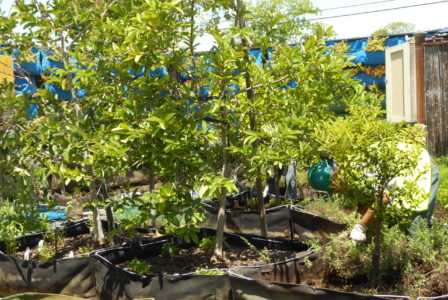More Facts and Ideas about Conserving Resources Part 3
The Garden Club’s May meeting at SDG&E’s Innovation Center ended with a presentation by Janet O’Dea of Powers Plumbing. She says that California’s population should be around 60 million by 2050. (SDG&E projects 51 million. Either way, it’s a lot of people wanting water for drinking, cleaning, or irrigation.) Californians may be deprived of some of their water needs by 2020. Meanwhile, the cost of water will grow.

SDG&E’s Innovation Center provides examples of ways to benefit from conservation.
A five minute shower after letting the water warm for a minute and a half uses 2.5 gallons a minute with an old shower head; the new ones produce 1.5 gallons a minute. Obviously we need to take shorter showers, save the “warming up” water in a bucket, and turn off the water while we soap our hair or bodies. Depending on the age of the toilet, each flush can use between 1.28 to five or more gallons of water. There is no need to run water while you brush your teeth. You only need water to clean your toothbrush and the sink. Washing your hands can take from a half to 2.2 gallons of water.
Appliances use water as well. A top loading washing machine consumes 55 gallons while a front loader uses half that amount. Dishwashers use four to six gallons a load with a pre-rinse feature. Skipping the pre-rinse saves ten gallons per load. Ten minutes of washing dishes by hand before loading them will use 27.5 gallons of water!
Leaks or just not turning the water off can waste up to 10,000 gallons a year. “37 per cent of people have water leaks,” she said. WaterSense says, “A leaky faucet that drips at the rate of one drip per second can waste more than 3,000 gallons per year.” An average household uses over 300 gallons per person per day. 70 percent of that is used indoors. The average household uses 146,000 gallons of water a year. (Internet: https://www.epa.gov/watersense/pub/indoor.html.)
To lower your water bill, replace sprinklers with a drip system. Inspect them for leaks. Adjust their timers monthly. Hand watering uses less water than sprinklers. Substitute drought-tolerant plants for lawn. Group plants according to water needs. Check your water pressure. You should have a pressure regulator at the back of your house, in front of your house, inside your house. Water pressure rises at night which is hard on your plumbing fixtures.
You can lessen your water usage in other ways, too. Pre-soak dishes in a container of water, wipe with a paper napkin, and only run the dishwasher when it is full. Set the lowest time setting for dishes and clothing. Change all faucets and shower heads to use 1.75 gallons or less per minute. Turn off faucets while you soap or wash your hair. Take shorter showers. Use a timer. Check your toilet for leaks putting food coloring in the toilet tank. If the bowl’s water shows color, you have a leak.
Another savings is using grey water (water that was used for washing) and rain water for irrigation. Be aware that grey water may contain detergents or other toxins that will be going straight into the ground. Many of our common soaps and detergents are not safe for plants, so consider the source of your grey water. A safer source than grey water is collected rain water.
A terrific way to save resources is to stop drinking bottled water. Bottled water uses 2000 times more energy than tap water. The bottle is made from petroleum products. Both bottles and water must be transported adding financial and pollution costs. Janet says, “Imagine when drinking out of the bottle that ¼ of it is oil.” Buying and using a water filter will pay for itself quickly. I carry a thermos of ice water with me everywhere I go. I am not only helping conserve resources but I am saving money as well.
O’Dea recommends doing periodic in-house inspections. Check for leaks, worn-out valves and supply lines. Turning off the water to the washing machine between uses saves wear on the water lines, and if one should spring a leak, you will know instantly. I walked into a house I was showing a buyer to discover that had happened. There was water at least an inch deep on all the downstairs newly refinished hardwood floors. (The buyer and I turned off the water and dried the floors.)
Remember that electricity from dams uses water from evaporation. Motion detectors keep lights off unused rooms; smart power strips and timers make turning items off easier. Use fans in lieu of air conditioning. Open a window. Go to the beach or to the zoo.
O’Dea concluded by giving us a city website to give you a free water survey. Call (866) 987-7367 or visit https://www.sandiego.gov/water/conservation/surveyprogram. Get your leaks repaired, replace water hogging appliances and get a filter for your drinking water.
November’s meeting will be on the 17th, a potluck for members only. We do not meet in December, so the next meeting will be January 25, 2017. John Bagnasco will speak on rose gardens around the world and horticultural vacations at the church at 4070 Jackdaw, between West Lewis and Fort Stockton, from 6 to 8 p.m. If you haven’t joined or renewed your membership, it would be good to do so now. It’s $35 for a single membership, $50 for a couple.
Category: Education, Life Style







